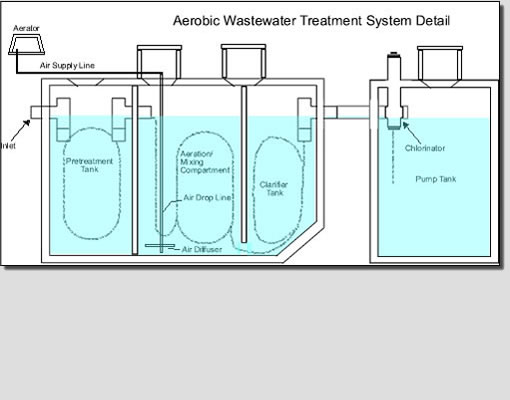
Types of Septic SystemsConventional SystemsGenerally there are two types of conventional septic systems: those that use gravel in the drainfield and those that use some form of chamber system. As its name suggests the older style gravelled system contains a layer of gravel in the drainfield. During construction, a drainfield ditch 1 to 3 feet below ground level is constructed. Its length is determined by the anticipated flow of effulent into the system from the home or rural office, as well as the soil's ability to absorb water. Washed gravel is poured into the bottom of the ditch, then over and around a perforated plastic pipe.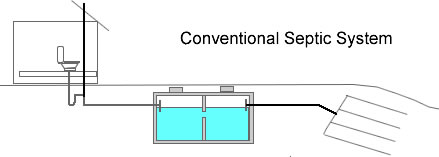 Additional gravel is poured around and over the pipe, then the gravel is covered by a semipermeable barrier such as geotextile fabric so that backfill soil doesn't filter between the rocks and
reduce the field's ability to absorb water. While some treatment of waste occurs in the septic tanks as bacteria within the tank operate on the waste, most of the treament occurs as wastewater discharged from the tank enters the drainfield and is filtered through the gravel and the soil below. Over time, bacteria and other organisms in the soil consume any organic material in the wastewater. These organisms multiply and form a layer called a biomat that sits on the soil layer. When sufficient oxygen is available, worms and other parasites feed on the bacteria as well as the material in the
wastewater. When the drainfield is in balance, these organisms keep the biomat from becoming so thick that it won't allow passage of wastewater to the soil below. Additional gravel is poured around and over the pipe, then the gravel is covered by a semipermeable barrier such as geotextile fabric so that backfill soil doesn't filter between the rocks and
reduce the field's ability to absorb water. While some treatment of waste occurs in the septic tanks as bacteria within the tank operate on the waste, most of the treament occurs as wastewater discharged from the tank enters the drainfield and is filtered through the gravel and the soil below. Over time, bacteria and other organisms in the soil consume any organic material in the wastewater. These organisms multiply and form a layer called a biomat that sits on the soil layer. When sufficient oxygen is available, worms and other parasites feed on the bacteria as well as the material in the
wastewater. When the drainfield is in balance, these organisms keep the biomat from becoming so thick that it won't allow passage of wastewater to the soil below.
Low-Pressure Dose SystemsLow-pressure dose systems (also known as low-pressure pipe systems) may offer an alternative where soil and topographical conditions do not permit placement of a conventional septic system. This is especially true where the topography requires the drainfield to be located up-hill from the the septic tanks or where there is uneven terrain that would otherwise preclude placement of a conventional system.Low-Pressure Dose Systems (LPDs) baiscally work like this: Beside the standard septic tank, an additional tank called a pumping chamber is installed. Under normal conditions, a low-pressure pump is turned on twice each day and forces wastewater in the pumping chamber to pass into the drainfield. Under an LPD application, the drainfield consists of small perforated pipes in shallow, gravel lined trenches 10" to 18" deep and 12" to 18" wide. Wastewater is pumped, or forced into the drainfield to the point where the entire field is saturated. Then the field is left to drain. This creates good aerobic conditions (aerated) thus promoting good bio-processing by bacteria and other parasites. Shallow placement also promotes evapo-transpiration, where evaporation and grass and other shallow rooted vegitation help eliminate wastewater. In an LPD system, the pumping chamber is designed to contain at least on extra day of effulent. More flow will cause alarms to be activated. With an LPD installation the drainfield is normally uphill from the septic tank to avoid the possibility of continuous distribution of effulent via gravity. When the drainfield are not located up-hill, the system will be designed is such a way that effulent will not leave the pumping chamber when the pump is turned off.
Evapotranspiration SystemsEvapotraspiration Systems (ETs) are typically feasible only in arid and semi-arid regions. Basically we are looking at climates where evaporation exceeds rainfall by at least 24" per year. The EP system relys on natural evaporation of wastewater through a sand barrier and simultaneous transpiration of water via the leaves of plants and grasses planted above the the drainfield.An ET system is similar to the systems described above except that the drainfield consists of a trench lined with an impervious barrier. At the bottom are perforated drainpipes surrounded by a layer of gravel. Above the gravel is a layer of sand that
is domed above the ground level.
Where the ground has some ability to absorb water, an ETA system may be employed. This is essentially the same system as an ET system with the exception that the drainfield is unsealed. This allows some of the water to perculate into the ground below the ETA beds. As a general rule, wastewater must be able to travel at least 2 to 4 feet of unsaturated soil before reaching ground water table. The advantage of an ETA over an ET system is the system's ability to operate in non-arid climates. In North Texas most permitting agencies require the construction of two fields and that the owner manually switch the wastewater flow between fields each month. Obviously, this requires a larger land area for evapotranspiration field, yet this system has no moving parts, electrical requirement and has less frequent maintenance demands than LPD or Aerobic Systems Aerobic Wastewater Treatment SystemsClearly aerobic septic systems are the one system that can be applied in almost any situation where septic systems are required. When you own an aerobic system you are basically the owner of a small version of a municipal sewage plant. That is, your aerobic system mirrors many of the steps and activities performed by an urban waste treatment plant. Aerobic systems are similar to septic systems in that both treat wastewater using natural processes. However, unlike the conventional septic system, the aerobic system injects oxygen via a pump into the tank. This increase in oxygen increases the natural bacterial consumption of waste within the system. The best aerobic systems provide a pretreatment tank as well as a final treatment tank with unstabilized chlorine. At this point the resulting discharge water is clean enough and pure enough to be discharged via sprinklers directly over the absorption field. This is a real plus to home owners who don't want to clear trees to create an absorption field and to other homeowners on lots close to a body of water that might otherwise be subject to potential polution.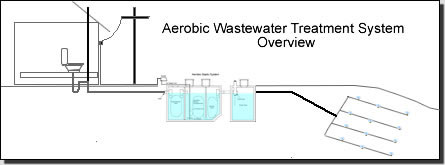
Many permitting agencies, including those in North Texas, are now requiring aerobic system installation for new home
construction as well as for failed conventional, LPD and Evapotranspiration systems. The clear environmental advantages of an aerobic system suggest that it may be the required system at some point in the future. An inexpensive maintenance contract will reduce the need for homeowner intervention and care.
Aerobic systems work like this: Wastewater and effulent enter a pre-treatment tank where grease, oils, toilet paper, and other solids and foreign materials are captured. This helps to reduce the amount of solids entering the aerobic chamber. Too many solids can clog the system and cause malfunctions. Next, the wastewater enters the aerobic chamber where air is compressed and forced into the wastewater to increase the growth of beneficial bacteria that consume the solids. However, not all solids are consumed by the bacteria, so the mixture next enters a setting or clarifying chamber where any remaining solids can settle. Next the treated water moves to a pumping chamber where is receives a final treatment of unstabilized chlorine. This is not the same chlorine as you use to shock your pool, but rather a highly concentrated, tablet form of chlorine specifically designed for the treatment of wastewater. A float valve within the pump chamber will signal the pump to discharge the water to absorption field. This treated water is then piped to the field and dispersed via pop-up sprinklers. Typically aerobic systems cost little more than conventional septic systems to install and maintain. Systems are specially designed with alarms and control boxes to assure that they are functioning properly at all times. Usually they are less expensive to install than LPDs or Evapotranspiraton systems as there is no need to condition a drainfield with sand and/or gravel. Because you are basically running your own wastewater treatment plant, it is essential to secure the services of a qualified professional in order to obtain the periodic certification letters required by most permitting agencies. This maintenance contract will assure you that your plant is functioning within specifications at all times. Manufacturers provide a two-year waranty contract as a part of the purchase price. At the end of this time you will need to either renew your maintenance contract or obtain one from another waste water treatment professional. Septic Solutions of Texas offers three levels of aerobic system maintenance contracts for aerobic system owners in North Texas. Click here for details. Regardless of the type of system you would like to install, the starting place for determining your options is a soil analysis by a professional engineer. Without this analysis you cannot obtain a construction permit.
|
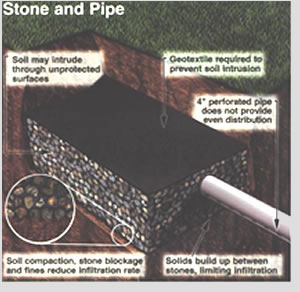 Gravelled or stone septic systems have some potential drawbacks. First, the use of gravel automatically, limits the effluent's ability to reach the soil where the majority of filtation takes place. Depending on
the size of the gravel, something like 50 to 75 percent of the potenial infiltrative area is blocked by the surface of the gravel. In addition, though responsible contractors use only washed gravel, a certain amount of fines inevitably remain and drop to the soil level further reducing potential filtration. One further potential problem of gravelled systems is the possibility of drainfield overload. This may occur when the water table rises above the drain pipe and effectively shuts down the drainfield's ability to discharge water. If this happens, it will be noticable as baths and toilets begin to back up. Then there is the possibility of drainfield overload that may occur when there are additional guests in the house for long periods of time or at times when faucets or toilets have been left running for prolonged periods. Again, once the system is overwhelmed the drainfield will fail to function and may become damaged to the point of needing to be replaced.
Gravelled or stone septic systems have some potential drawbacks. First, the use of gravel automatically, limits the effluent's ability to reach the soil where the majority of filtation takes place. Depending on
the size of the gravel, something like 50 to 75 percent of the potenial infiltrative area is blocked by the surface of the gravel. In addition, though responsible contractors use only washed gravel, a certain amount of fines inevitably remain and drop to the soil level further reducing potential filtration. One further potential problem of gravelled systems is the possibility of drainfield overload. This may occur when the water table rises above the drain pipe and effectively shuts down the drainfield's ability to discharge water. If this happens, it will be noticable as baths and toilets begin to back up. Then there is the possibility of drainfield overload that may occur when there are additional guests in the house for long periods of time or at times when faucets or toilets have been left running for prolonged periods. Again, once the system is overwhelmed the drainfield will fail to function and may become damaged to the point of needing to be replaced.
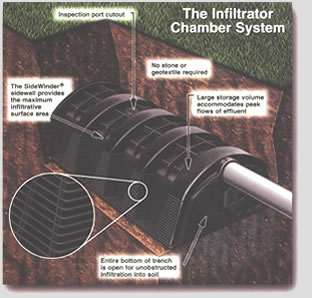 Gravelless conventional systems overcome some of the drawbacks of gravelled systems. These drainfield systems consist of a series of connected chambers that are typically 15 to 40 inches in width.
Typically these chambers are manufactured of molded high-density plastic in 10' to 12' foot lengths. Some systems include pipes within the chamber, others do not. Septic Solutions of Texas exclusively uses the
Infiltrator chamber system as we have found this system to most effective when allowed in North Texas soils. Native soil is compacted slightly around the chambers to provide stability and then filled in above the chamber. When placed into service, waste water is carried by pipe from the septic tank to the chamber run and flows directly against the soil. As in the gravelled system a bio mat forms on or near the soil level and
works to consume solids that pass out of the septic tank. One real advantage of the chambered system is its ability to hold much larger amounts of water. This is useful in locales where the water table can rise close to the surface and in instances when there is a temporary surge as a result of extra guests. Obviously shock loading over prolonged periods of time is going to be detrimental to the biomat as oxygen will not be
available to parasites during these periods.
Gravelless conventional systems overcome some of the drawbacks of gravelled systems. These drainfield systems consist of a series of connected chambers that are typically 15 to 40 inches in width.
Typically these chambers are manufactured of molded high-density plastic in 10' to 12' foot lengths. Some systems include pipes within the chamber, others do not. Septic Solutions of Texas exclusively uses the
Infiltrator chamber system as we have found this system to most effective when allowed in North Texas soils. Native soil is compacted slightly around the chambers to provide stability and then filled in above the chamber. When placed into service, waste water is carried by pipe from the septic tank to the chamber run and flows directly against the soil. As in the gravelled system a bio mat forms on or near the soil level and
works to consume solids that pass out of the septic tank. One real advantage of the chambered system is its ability to hold much larger amounts of water. This is useful in locales where the water table can rise close to the surface and in instances when there is a temporary surge as a result of extra guests. Obviously shock loading over prolonged periods of time is going to be detrimental to the biomat as oxygen will not be
available to parasites during these periods.
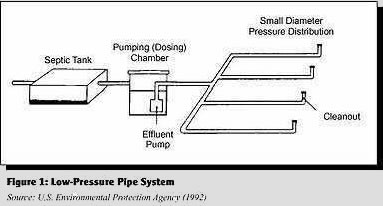 Beyond the topographical site advantages of LPDs mentioned above, there is a significant reduction in the land area required by the absorption field compared to conventional systems. In addition, the use of a low-pressure pump means that
the entire drainfield will be used uniformly. And narrow, shallow trenches reduce some of the enevitable soil-compation that is commonly associated with the construction of
conventional drainfields. But LPDs do have drawbacks: there is the potential for infiltration by roots and clogging of drain holes by solids that escape the pumping chamber. There is also the possibility of wastewater
accumulation in the trenches. Finally, LPDs require regular maintenance. The addition of electricity, a pump and smaller drainfield increase the possibility of system malfunctions. Consequently, most permitting authorities now require annual
or semi-annual inspections by licensed septic professionals.
Beyond the topographical site advantages of LPDs mentioned above, there is a significant reduction in the land area required by the absorption field compared to conventional systems. In addition, the use of a low-pressure pump means that
the entire drainfield will be used uniformly. And narrow, shallow trenches reduce some of the enevitable soil-compation that is commonly associated with the construction of
conventional drainfields. But LPDs do have drawbacks: there is the potential for infiltration by roots and clogging of drain holes by solids that escape the pumping chamber. There is also the possibility of wastewater
accumulation in the trenches. Finally, LPDs require regular maintenance. The addition of electricity, a pump and smaller drainfield increase the possibility of system malfunctions. Consequently, most permitting authorities now require annual
or semi-annual inspections by licensed septic professionals.
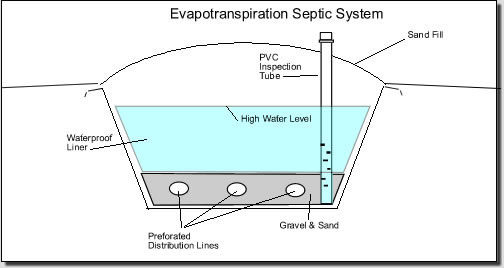 100 percent of all wastewater is absorbed into the atmosphere via evaporation through the sand and transpiration of plants and grasses. Naturally this type of system works best during the spring, summer, and fall seasons when heat and
sunlight provide the best wastewater processing. For this reason, ET systems are often chosen for summer home and cottages where winter use is limited and occasional. A good application is in areas with shallow soil depths and impermeable rock or hardpan
layers below. There is the potential for overloading the system as a result of extraordinary percipitation. And there is the potential for salt buildup at the surface when the system has been in use for a long period of time.
100 percent of all wastewater is absorbed into the atmosphere via evaporation through the sand and transpiration of plants and grasses. Naturally this type of system works best during the spring, summer, and fall seasons when heat and
sunlight provide the best wastewater processing. For this reason, ET systems are often chosen for summer home and cottages where winter use is limited and occasional. A good application is in areas with shallow soil depths and impermeable rock or hardpan
layers below. There is the potential for overloading the system as a result of extraordinary percipitation. And there is the potential for salt buildup at the surface when the system has been in use for a long period of time.
